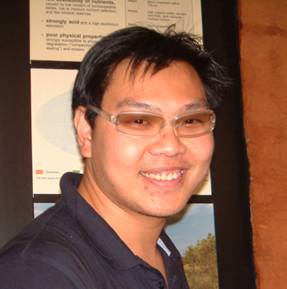The mission to promote Sponge Cities in Asia-Pacific Region – Insights from Faith
Published in Earth & Environment

What inspired you to pursue a career in urban water management, and what do you find most rewarding about your work?
I started with urban water/flood management as an undergrad to understand the water cycle and its relationship to the urban environment (cities) in Auckland. People in New Zealand care and love their environment and that makes me learn the best practices from them and could contribute back to other places in the Asia-Pacific Region. Then I got opportunities to work with the Environmental Protection Department, and the Hong Kong SAR Government on dealing with the leachate leakage issues from the landfill sites in Hong Kong. I realised the importance of protecting our communities and neighbourhoods because the leachate is highly toxic. Afterwards, I received opportunities and scholarships from DAAD (the German Education Exchange) to study agricultural and soil management at the University of Bonn. I was lucky supervised by Prof Wulf Amelung, the top soil scientist in the EU and he sent me to Uzbekistan on my Master's thesis project to improve the soil organic matter in the dryland soil in 2005-2006. During that time, I realised further the necessity and importance of “water”. Because Uzbekistan needs substantial irrigation to ensure the crop grows immensely well. Otherwise, that is difficult for us to work on improving the topsoil quality of the organic matter.
Afterwards, I moved to the University of Leeds and worked with Adrian McDonald, and Gordon Mitchell and also supported Joseph Holden at the Water@Leeds Institute. We contribute to different remits and research scopes focusing on water research. I was interested in looking at sustainable flood management solutions for managing the Pearl River Delta (my home – as I was born in Hong Kong). We explored some interesting ideas on Nature-Based solutions that integrated with the Natural Flood Management (NFM) concepts from the UK at that time. Moreover, I have had a chance to work with the University of Nottingham (where I am based now) with Prof Colin Thorne on developing the Blue-Green Cities concepts and ideas together with the research team across Nottingham, Leeds, Newcastle, Cambridge, UWE, etc., which aligns with the Sponge Cities concept in China (during 2013s onward). That makes me in the last decade just focused on urban flood management particularly finding new ways to work together with the Sponge City concepts in the Chinese cities such as Ningbo, Guiyang, Shenzhen, etc.
I have found this concept and the research I am doing making a real impact to “change” the Chinese cities. For example, I see the Sponge urban park established in Ningbo, sometimes, I will go there for a walk and enjoy our restored blue-green spaces which means a lot to me as I feel I bring something to the society and cities I belong to.
How do Sponge Cities change the urban future in China in your opinion?
No doubt China has been developing so fast since the late 1970s after the “Open-Door” National policy was delivered. You can see how fast some Chinese grow. Such as Shenzhen was a fisherman town with less than 300,000 populations in the early 1980s. But now the population has doubled in Hong Kong (border connected) to more than 15 million. The urbanisation rate of all Chinese cities on average is ranked top in the world. The Chinese National Government understood the importance of promoting “Green” and the necessity to protect the environment. In 2013, the Government announced the “Sponge City Program” and established legislation in 2014 to take on the real practice by publishing the amendment of the “Construction Guidance of Sponge City”. Then the “Sponge Cities” idea become the hotspot. I have to say the Sponge City concept is great but not perfect, there is still a lot of work to do. But at least, I have witnessed by working with scholars and stakeholders, that we are trying our best to restore our urban environment by improving the urban ecosystem services and care of our vegetation, birds, butterflies, bees, insects, soil, water and groundwater. That is an important start and a big step in planning the urban future for the next generations in all Chinese cities. I also have a lot of colleagues worldwide, not only from the EU and the United States but even from the Global South countries in Africa, South America and C America are asking about the Sponge Cities as they see the progress and ambitions of the Chinese Government aimed to restore the urban environment with more blue-green spaces for extracting better urban water resources but deliver multiple benefits and social well-being to the communities.
You have published the Sponge City research in the Scientific Reports – can you tell us how has publishing with our journal influenced your research?
Our research team have published two articles in the Scientific Reports both are related to the Sponge Cities concept. You will find that we are doing something quite innovative as we are not just working on traditional flood management issues. For example, our paper (Lu & Chan et al. 2022) uses the GDELT GKG analyses by using the news media analytics method that looks an alternative way by news media sources were posted during the flood events. These results can inspire us and the stakeholders because we got more information from the reports by media rather than our traditional post-flood reports and modelling simulation results. Another paper (Lu et al. 2024) we published in the journal is also impactful and interesting in that we are looking at using the bioswales in China and evaluate how that may contribute to improving the urban discharge particularly reducing the pollutants via swales. Swales are very popular in US cities such as Portland and Seattle, but we do not know too much about the performance of swales in China. This paper is also very impactful to show readers how the swales in China can do in different rainfall patterns and we project with the future climate change scenarios. After publishing these two papers in the journal, which was very impactful. Honestly, some journalists did read the articles and contacted me to understand further about Sponge Cities and create a lot of impact and sharing. I can share that is a good choice to get your outstanding paper to be published here at Scientific Reports.
What was the decision process in choosing where to publish?
Normally I do a very careful check on the scope and aim of the journal before deciding the submission and publishing in “that” journal. Moreover, I do also check the recently published outputs from the journal. For example, if I want to publish hydrological issues I will first consider “Nature Water” (in Nature journal categories), but if the topics are generally broad I will consider “Nature Communications” or “Scientific Reports” or “Communication of Earth and Environment”. That needs to be carefully selected in my opinion and that will be very helpful to Editors (because I am also the editor of journals).
How do you think publishing in an open-access journal like Scientific Reports has impacted the visibility of scientific research?
Publishing in an open-access journal like Scientific Reports I believe it's very helpful to improve the visibility for sure as there are quite a few people who emailed me/us after our papers were published at Scientific Reports. That provides convenience and a free download mechanism for their readers. That will certainly help readers to go through the paper and follow up on some major issues in the past 5 years.
What advice do you have for other researchers on maximizing the dissemination of their work?
Likewise, as we discussed above I repeat that you should look at the journal's scope and aims but also look at the citation conditions, and have your paper published in the Scientific Reports, which will create loads of buzz and attract more attention from the public and stakeholders.

Can you tell us about your current research and how it relates to Sustainable Development Goals?
Our research is highly related and comes across several Sustainable Development Goals, such as addressing poverty and vulnerable communities for SDG1, we are looking at SDG 6 on water, SDG 11 on building sustainable communities, SDG 13 on climate change and other SDGs related to terrestrial and coastal estuarine aspects. Thus, our research is very diverse and important to contribute towards our major goal of delivering sustainable development particularly as I spoke above – to contribute to our urban future and benefit the next generations, not only for the Chinese cities but in the Asia-Pacific Region.
Follow the Topic
-
Scientific Reports

An open access journal publishing original research from across all areas of the natural sciences, psychology, medicine and engineering.
Related Collections
With Collections, you can get published faster and increase your visibility.
Obesity
Publishing Model: Hybrid
Deadline: Apr 24, 2026
Reproductive Health
Publishing Model: Hybrid
Deadline: Mar 30, 2026





Please sign in or register for FREE
If you are a registered user on Research Communities by Springer Nature, please sign in